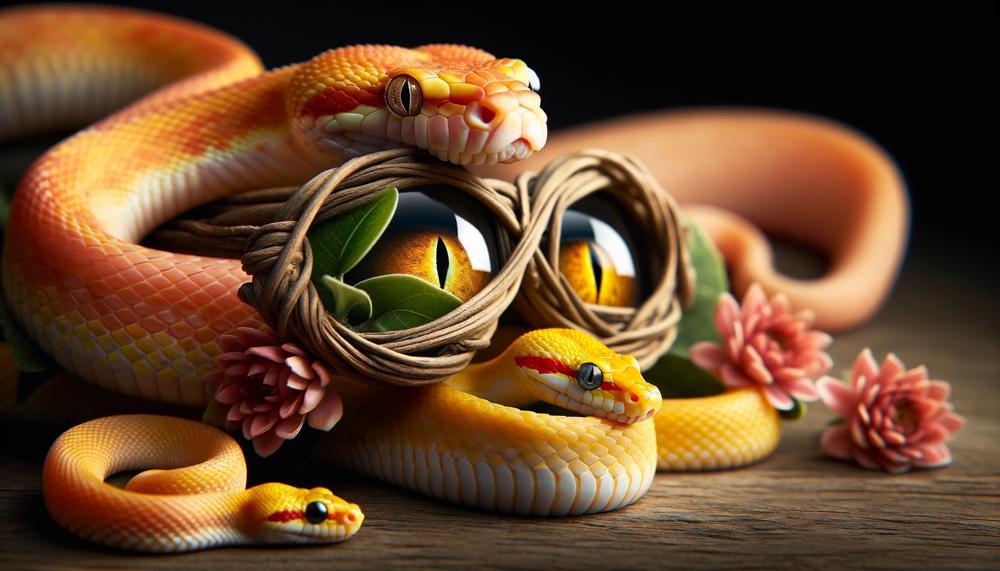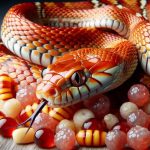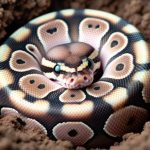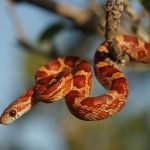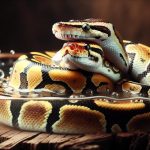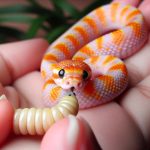Often surrounded by myths and misunderstandings, the visual capabilities of these captivating reptiles are a testament to their adaptability and survival skills. In this article, we’ll dive deep into the realm of corn snake vision, unraveling the truths and discarding the myths.
Corn snakes, contrary to some popular beliefs, are not blind. Their vision plays a crucial role in their daily activities, from hunting to navigating their environment.
However, understanding how they see the world requires us to look beyond our human perspective and into the fascinating adaptations that have enabled them to thrive.
Contents
Key Takeaways:
- Corn snakes possess unique visual capabilities tailored to their ecological needs.
- Their vision, while different from human sight, is effective for hunting and survival.
- Environmental factors and the snake’s lifecycle impact their visual acuity.
Join us as we explore the remarkable sensory world of corn snakes, shedding light on how these creatures perceive their surroundings and debunking the common myth of their blindness.
This journey will not only enhance your knowledge but also deepen your appreciation for the intricate connections between species and their habitats.
Corn Snake Eye Structure
The unique eye structure of a corn snake encompasses large eyes equipped with elliptical pupils, enhancing their vision across varying light conditions.
This distinctive eye morphology not only bolsters their sight in both brightly lit and dim environments but also underpins their survival by fine-tuning their predatory and navigational capabilities.
| Feature | Description | Impact on Vision |
| Elliptical Pupils | Enables variable light intake. | Improves vision in diverse lighting, aiding in hunting and exploration. |
| Large Eyes | Collects more light. | Enhances low-light vision, crucial for nocturnal activities. |
| Nearsightedness | Limited focus beyond a few inches. | Relies on close-up visual cues for detecting prey and threats. |
| Color Vision | Perception of red, green, blue, and shades therein. | Assists in identifying prey and navigating their environment. |
| UV Light Sensitivity | Can see ultraviolet light. | Enables tracking of prey trails invisible to many predators. |
| Motion Sensitivity | Specialized brain regions for processing motion. | Crucial for detecting moving prey and evading predators. |
| Depth Perception | Good spatial awareness. | Facilitates precise striking at prey and adept movement through complex terrains. |
| Night Vision | Tapetum lucidum layer in eyes. | Allows for superior nocturnal hunting by reflecting light within the eye. |
Corn snakes’ vision, characterised by its adaptability and precision, is integral to their way of life.
Their eyes, while not matching the acuity of mammals or birds, are finely tuned instruments that support their predatory habits, aid in avoiding predators, and enhance their interaction with the environment.
By marrying sensitivity to motion with the capability to see in UV and varied lighting conditions, corn snakes possess a visual system that’s both unique and remarkably efficient, facilitating their success as nocturnal hunters and agile navigators of the diverse landscapes they inhabit.
Visual Acuity of Corn Snakes
Corn snakes, with their adept visual acuity, are fascinating creatures when it comes to their hunting strategies and navigation through their environment.
Their large eyes, equipped with elliptical pupils, grant them the flexibility to adapt to varying light conditions, thus aiding their survival.
Here’s a look into how these slithery beings utilise their sight to its fullest.
Hunting with Precision
| Detection of Prey | Corn snakes can spot the slight movements of prey due to their highly sensitive motion detection. This ability is crucial for pinpointing the location of potential meals. |
| Judging Distances | With excellent depth perception, they accurately gauge the distance to their target, ensuring a successful strike with remarkable precision. |
| Night Vision | Their exceptional night vision allows them to hunt effectively in the dark, a time when many of their prey are active. |
| Environmental Cues | Visual cues such as the layout of the terrain and variations in light help them navigate and understand their surroundings. |
| Temperature Awareness | Being ectothermic, maintaining an optimal temperature is vital for their vision and overall health. They use visual information to find sunlit areas or shade as needed. |
| Social Signals | Visual signals are employed during courtship and territorial disputes, allowing them to communicate effectively without direct contact. |
Corn snakes’ vision, although not their only sense, plays a significant role in their daily activities. Their ability to see well in both bright and dim light, combined with their unique adaptations like UV light sensitivity and excellent night vision, empowers them to be efficient predators and keen navigators.
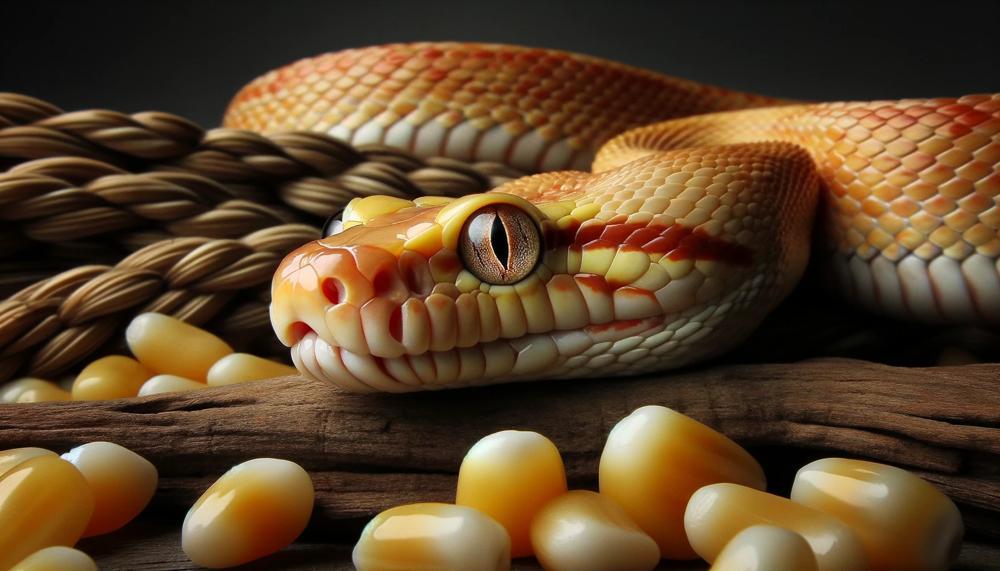
Whether it’s pinpointing a mouse in the underbrush or finding a mate, their eyes are vital tools for survival.
Corn Snake Color Perception
Corn snake’s color perception, whilst not as rich as in some species, plays a pivotal role in their survival in the wild. They see the world differently from us, focusing on red, green, and blue spectrums, along with an ability to detect UV light.
This unique vision helps them in various facets of their life, from hunting to evading predators and even in social interactions.
| Aspect | Role of Color Perception | Impact |
| Locating Prey | UV vision to follow urine/feces trails | Enhances ability to track down prey efficiently |
| Motion Detection | Contrast detection in limited color range | Facilitates the spotting of moving prey against varied backgrounds |
| Depth Perception | Essential for accurate striking | Crucial for capturing prey with precision |
Avoiding Predators
Corn snakes use their color vision combined with sensitivity to motion to detect threats in their environment. This ability allows them to hide or flee from predators, contributing to their survival.
Social Interactions
Their color vision aids in recognizing mates and rivals, which is vital during mating season and when establishing territories. Visual cues, such as color and patterns, play a significant role in these interactions.
Environmental Adaptation
Corn snakes living in different habitats may develop variations in their color perception abilities. Those in lush environments benefit from enhanced color vision for navigating dense foliage, while snakes in more monochrome habitats might rely more on depth perception and motion detection.
Adaptations for Nocturnal Vision
Corn snakes, those slinky creatures of dusk and dawn, are marvels of nature when it comes to navigating the shadowy world.
Their physical adaptations for seeing in low light are not just fascinating; they’re a brilliant showcase of evolution’s ingenuity. Here’s how these serpents shine in the dim:
| Tapetum Lucidum | This reflective layer sits behind the retina, bouncing back any light that passes through, giving the corn snake’s eyes a second chance to capture light. It’s like having built-in night goggles. |
| Infrared Sensing | Corn snakes are equipped with a sensory prowess that allows them to detect the heat signatures of their prey, making them adept hunters in the absence of light. It’s akin to having a thermal imaging camera. |
| Abundant Rod Cells | With a scarcity of cones for colour vision but a wealth of rods for low-light detection, these snakes are tuned to thrive in dim conditions, seeing the world in varying shades of grey but with impeccable clarity. |
| Vertical Slit Pupils | Their pupils can expand significantly in low light, maximising the amount of light entering the eye. This adaptation is perfect for nocturnal exploits, allowing them to spot even the subtlest movements in the dark. |
| Supplemental Senses | Besides their extraordinary vision, corn snakes utilise heat-sensing organs and vibration detection to navigate and hunt, ensuring they’re well-attuned to their environment, even on the darkest nights. |
Corn snakes, therefore, are not just about the allure of their vibrant scales or the sinuous grace with which they move. They are, in every sense, creatures perfectly adapted to their twilight world, using a combination of refined visual adaptations and supplemental senses to navigate, hunt, and exist in their dimly lit niches.
Hunting Strategies and Visual Cues
Corn snakes, with their keen eyesight and specialized vision capabilities, are fascinating creatures when it comes to hunting. They rely heavily on visual cues to spot their prey, employing a blend of motion detection, color distinction, and UV light perception.
| Visual Cue | Function | Impact on Hunting |
| Motion Detection | Sensitive to even slight movements. | Allows the corn snake to pinpoint live prey effectively. |
| Color and UV Light Perception | Can distinguish between shades of red, green, blue, and detect UV light. | Enables tracking of prey via urine or feces trails not visible to the human eye. |
| Depth Perception and Night Vision | Excellent depth perception and specialized night vision. | Facilitates accurate strikes in various lighting conditions, crucial for nocturnal hunting. |
Corn snakes, equipped with large eyes and elliptical pupils, excel in both bright and dim lighting, adapting their hunting strategies accordingly. They’re nearsighted, focusing on objects mere inches away. This trait, while limiting long-distance vision, sharpens their focus on nearby prey. Their limited color vision, complemented by the ability to see UV light, guides them to prey trails invisible to many predators and prey alike.
The snake’s sensitivity to motion is a key hunting tool. It helps them detect the slightest movements in their environment, signaling the presence of potential prey. Their good depth perception is crucial for timing their strikes with precision, ensuring they capture their target more often than not.
Environmental factors also play a role in their visual hunting strategies. Snakes in areas with dense vegetation might leverage their color vision more, while those in rocky terrains rely on depth perception to navigate and hunt.
Furthermore, corn snakes use visual cues for communication, especially during courtship or territorial disputes, displaying body postures and color changes to signal their intentions to other snakes.
Corn Snake Response to Movement
Corn snakes, with their keen senses, exhibit fascinating responses to movement, reflecting their natural hunting instincts and adaptability.
Understanding their behavior towards movement not only aids in proper handling but also in ensuring their well-being in captivity.
Reactions to Movement: A Detailed Insight
Corn snakes are attuned to their environment, using their acute senses to navigate and interact. Here’s how they typically respond to movement around them:
| Stimulus Type | Response | Reasoning |
| Subtle | Curiosity | Investigates gently, driven by inquisitiveness. |
| Rapid | Defensive | Perceives as potential threat; may coil or flee. |
| Consistent | Acclimatization | Becomes accustomed over time; shows reduced fear. |
Adapting to Human Interaction
Handling practices significantly influence a corn snake’s reaction to human movement. Gentle, predictable handling fosters trust, whereas abrupt or aggressive movements can instill fear. Here’s how to ensure a positive response:
- Initial Caution: Allow your snake to acclimate to its new home for about two weeks before initiating handling.
- Gradual Introduction: Start with brief, gentle sessions, slowly extending time as comfort grows.
- Predictability: Always approach your corn snake from the side and avoid overhead threats to minimize stress.
- Guided Exploration: Let the snake move freely in your hands, providing support and direction without restriction.
Understanding Defensive Behavior
Occasionally, corn snakes might react defensively to sudden movements, especially if they confuse your hand with prey or feel threatened. Maintaining calm, steady motions and avoiding handling after feeding can mitigate these responses.
The Importance of Routine
Consistent handling routines contribute to a corn snake’s ability to trust and feel secure.
By respecting their natural reactions to movement and adapting your interactions accordingly, you cultivate a healthy, stress-free environment for your pet.
The Role of Heat Sensing in Corn Snake Vision
Corn snakes, although lacking the advanced infrared heat-sensing capabilities of some of their serpent kin, have a unique approach to integrating heat cues with their vision.
They primarily rely on their keen eyesight for navigation and hunting, but they also use their thermal sensitivity to complement their visual perception, especially in low-light conditions where visual cues are less reliable.
Sensory Integration
Corn snakes possess an intrinsic ability to merge thermal sensitivity with their visual inputs.
This dual sensory input enhances their hunting efficiency, allowing them to detect warm-blooded prey even in the dark, by sensing slight temperature variations in their environment.
Enhanced Predatory Skills
The integration of heat sensing bolsters their predatory skills, enabling them to track, pinpoint, and strike their prey with remarkable accuracy.
This is particularly vital as they often hunt nocturnally, when their visual acuity is diminished.
Environmental Adaptation
Their ability to sense heat aids in environmental adaptation, guiding them towards thermally optimal habitats, crucial for their metabolism and overall well-being.
It ensures they can find suitable basking spots to regulate their body temperature, essential for digestion and energy conservation.
Table: Corn Snake Sensory Integration
| Sense | Function | Benefit |
| Visual | Hunting, navigation | Precise prey tracking |
| Thermal Sensing | Prey detection, habitat selection | Enhanced predatory efficiency, optimal environmental positioning |
Conclusion
In the vibrant tapestry of the natural world, corn snakes emerge as exemplars of evolutionary artistry, particularly through the lens of their visual and sensory capabilities.
Far from the misconceived notion of blindness, these serpents boast a visual system intricately designed for survival, finely tuned to the nuances of their environment. Their vision, a kaleidoscope of adaptations from the ability to perceive a spectrum of colors to the unique sensitivity towards ultraviolet light, underscores their adeptness in hunting and navigation.
The marvel of their sight lies not just in the clarity of day but shines even brighter in the cloak of night, thanks to a remarkable night vision facilitated by the tapetum lucidum layer. This, coupled with their ability to sense heat and detect the slightest movement, positions them as formidable nocturnal hunters, navigating and thriving in the dimmest conditions.
Corn snakes remind us of the profound interconnectedness of life, where every adaptation has a purpose, every feature a role in the grand survival game. They are a vivid testament to the ingenuity of nature, embodying the essence of adaptability and the intricate dance between predator and prey.
Through understanding the corn snake’s world, we not only debunk myths but also deepen our appreciation for the complexity and wonder of the natural realm.

